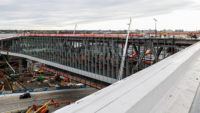U.S. ports say they need $28.9 billion in upgrades to roads, rail, bridge and tunnel links over the next 10 years to handle the heavy volume of freight they expect, according to a new American Association of Port Authorities report.
The AAPA State of Freight survey, whose results were released on April 21, says, “Investment in America’s port-connection infrastructure is a critical national priority.”
AAPA says that, from 2000 to 2013, the container volume that moved through U.S. ports rose by about 50%, to 44.6 million 20-ft equivalent units, increasing the load on their rail and highway infrastructure.
The more than 75 ports that responded to the survey—a 95% response rate—said they had 135 freight-related "landside" projects as priorities through 2025.
Of the $28.9-billion total, north Pacific ports report needs of $6.9 billion, and south Pacific ports requirements are $6.5 billion, followed by north Atlantic ports, at $6.4 billion; south Atlantic ports, $4.6 billion; Gulf ports, $4.1 billion; and Great Lakes ports, $333 million.
Looking at project categories, the largest share is $19.5 billion for 34 projects with national or regional importance.
The list also includes 46 intermodal projects, valued at $7.5 billion, and 35 projects, worth $1.9 billion, that are potential candidates for federal Transportation Investment Generating Economic Recovery (TIGER) grants.
About a third of the ports responding to the AAPA survey said they each need at least $100 million to improve intermodal links; 18% said they require a minimum of $50 million, and 30% estimated their minimum need at $10 million.
Ports are looking to the federal government for help in funding these landside projects.
The study notes that a 2012 AAPA survey showed that ports planned $45 billion over five years for improvements to piers, container-handling equipment and other core infrastructure. But the group says, "This investment is not being adequately matched by a federal government commitment to improve the corresponding connecting infrastructure."
AAPA says the 2012 MAP-21 surface-transportation law made some port landside projects eligible for federal highway funds, but it adds that competition for that money is rough because many other types of road projects also are eligible for that aid.
Ports have had some success in winning U.S. Dept. of Transportation TIGER grants for maritime or related projects, but competition for those dollars—which go for a range of surface transportation types—has been extremely intense.
Ports have another crack at TIGER money: U.S. DOT on April 2 launched its latest round of the popular grants, the seventh since the program began in 2009. Congress appropriated $500 million for this year's TIGER round. DOT set a May 4 deadline for pre-applications. Final applications are due on June 5.
Another federal resource is DOT's Transportation Infrastructure Finance and Innovation Act (TIFIA) program, which offers low-interest federal loans to help finance projects. But the AAPA report says only 8% of ports responding to the survey used TIFIA loans on projects.
The report adds, "Many ports have reported having experienced difficulty with how U.S. DOT interpreted their TIFIA applications, concluding that U.S. DOT doesn't encourage port-supported TIFIA projects."
Private-activity bonds, another financing source, is more popular among ports, with 34% saying they have used or plan to use them.
Ports also said congestion has worsened at their landside transportation links, with 15% reporting that the jams have risen to 100% from 50%. Another 18% said the snarls have increased to 25% from 10%.



Post a comment to this article
Report Abusive Comment